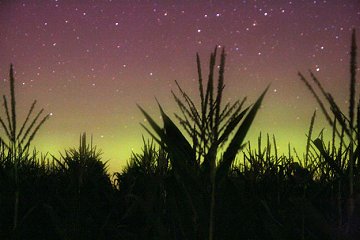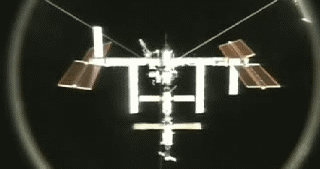 Where's Saturn? Is that a UFO--or the ISS? What's the name of that star? Get the answers from mySKY--a fun new astronomy helper from Meade. Where's Saturn? Is that a UFO--or the ISS? What's the name of that star? Get the answers from mySKY--a fun new astronomy helper from Meade. ASTROPHOTO-OP: Tonight, 9th-magnitude Comet LINEAR VZ13 glides past globular cluster M3 with only 20 arcminutes separating the two. At closest approach, around 23:30 UT on July 22nd, the comet's atmosphere may actually overlap the cluster's starry fringe. This is an event for mid-sized backyard telescopes. Because of the timing of the encounter, Europran observers are favored. [sky map] [ephemeris] [3D orbit] PHOTOGRAPHIC AURORAS: On July 21st, auroras billowed over the corn fields of central Wisconsin. To the naked eye they were dull and almost unnoticable, but a 28 second exposure with Tony Wilder's Canon30D revealed a different picture: 
"Auroras in summer! Christmas came 6 months early," says Wilder. The source of the display was a solar wind stream that hit Earth late on July 20th, rattling Earth's magnetic field and producing a storm of magnitude 5 on the 0-to-9 Kindex scale of geomagnetic activity. Another solar wind stream is due on July 26th. Ready your cameras! SPACE STATION WORM: What flies through space and wriggles like a worm? Before you answer, take a look at this movie of the International Space Station (ISS): 
Click to view a longer movie: wmv, mpg, avi.
The footage comes from space shuttle Atlantis, which was flying around the ISS on June 19th after undocking. Cameras on the shuttle recorded not only the behemoth space station, but also a strange wriggling object moving in front of the station's solar panels and radiators. What is it? Veteran satellite observer John Locker of Wirral, England, who intercepted NASA's Ku band satellite TV link as the two spacecraft orbited over the UK and thus recorded a full-length movie of the object, calls it the "space station worm." At first he thought it might be an item lost by a spacewalking astronaut. "It looks a lot like the strap hanging down from Steven Swanson's waist," he points out: image. But the worm seems much too big for that. Another possibility is ice. Space journalist Jim McDade notes that "pieces of ice have been flying off spacecraft since the Mercury days. Don't forget John Glenn's fireflys. Ice tends to dance and roll as it sublimates in the microgravity, near vacuum of space." For instance, a ring of ice dislodged from the shuttle's thruster nozzles, bent and tumbling, might produce a semblance of wriggling. One thing we're sure it's not: a real worm. Ideas are welcomed.
.2007 Noctilucent Cloud Gallery
[Night-Sky Cameras] ["Noctilucent Cloud"--the song] | 
